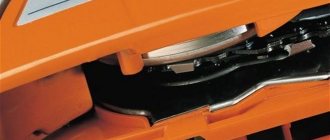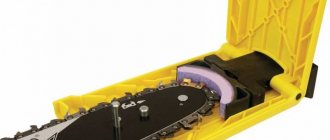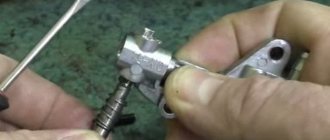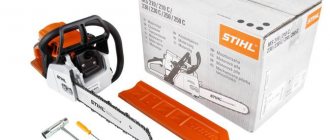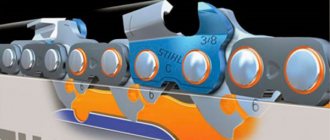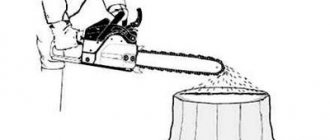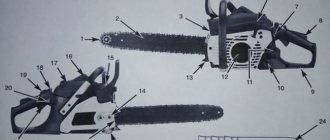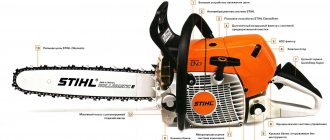Is it possible to shorten
The chain on the saw breaks, this is a common occurrence and there is no need to be upset. Manufacturers have made sure that chains can be repaired and shortened. On sale are spare links for chains of different types and sizes, rivets for chains, riveting and riveting machines.
Using machines, you can rivet a chainsaw chain at home even for those who have never done anything like this.
Important: chain repair, even the highest quality, does not guarantee that it will last forever. The links wear out evenly, so at any moment the chain can break in another place.
Chains are available for sale in coils of 50-100 meters, which you can buy and rivet yourself.
Coils are beneficial for professionals who use chainsaws every day, for example, forest fellers or sawmill workers.
Briefly about the main thing
A chainsaw consists of a motor, a filter, a starter, a gearbox, a clutch, a tire with a chain structure, a tensioner, a brake, and a lubrication mechanism. It works according to a classic carburetor scheme using a fuel mixture of gasoline and low-grade gasoline. The main parameters influencing the suitability of a chain for specific application conditions are the types of teeth and their characteristics, profile, shank thickness and length.
Installation and tensioning of the chain must be carried out strictly in accordance with the specified algorithm and compliance with the rules. When choosing it, the following number of parameters are taken into account:
- Step size.
- Working tooth shape.
- Shank width and cutting depth.
- Manufacturer.
At the same time, even the best chainsaw chains are not without their main drawback - sagging, which can be caused by a faulty tire, natural deformation of the metal links and weak or incorrect fixation of the sprocket.
Why does it stretch?
Saw owners often ask the question: “why does the chain on a chainsaw stretch?” Let's try to answer it. A saw set can stretch for several reasons.
- The oil pump is faulty or incorrectly adjusted. Limited or no oil supply results in excessive heat during operation. The hot chain stretches several times faster.
- Working in adverse conditions. Dust, dirt, and soil get on the headset during operation. The dirt particles act as an abrasive material and gradually rub the joints of the links, causing it to stretch.
- Using poor quality chain lube. Often, the oil used to lubricate the chain is not the oil recommended by the manufacturer, but used oil from the car engine. The “working off” contains metal particles, which can also give the effect of an abrasive material.
- The chain is new. Manufacturers of chainsaws specially make adjustment screws on the saw, since the stretching process is inevitable.
- Natural stretching as a result of prolonged work.
Stretching is inevitable, the question is how quickly it will happen. You can extend the service life by using high-quality lubricating oils, carrying out timely diagnostics of the oil pump and taking breaks in operation.
Such measures can significantly reduce the likelihood of sprains, but not completely eliminate them.
Troubleshooting
The most important and dangerous problem for the user of a chainsaw, which sometimes cannot be eliminated even by replacing the chain, is a malfunction such as sagging, and neither Shtil brand models nor products from other well-known manufacturers are protected from it. They are caused primarily by the following reasons:
- Tire fault. Wear of the threaded part of the fastening bolts leads to vibration and loosening of the tension. It is necessary to regularly check the condition of the fasteners and replace them if necessary.
- Chain stretching. Sooner or later, due to natural laws, the metal of the links is structurally deformed and stretched to the limit. As a result, the chain cannot be tensioned. It needs to be completely replaced with a new one.
- Weak fixation or uneven installation of the sprocket. Troubleshoot the beam in a specialized workshop. Since precise adjustment will require disassembling the device and removing many parts.
Reference! Stretching of the chain structure occurs due to 3 main reasons - initially low-quality metal alloy of the links, excessive chain tension and poor-quality or incorrectly selected lubricant.
The chain has stretched, what should I do?
If the chain has stretched, but the wear of the links still allows it to be used, you can rivet it and continue working. Determining the number of links that need to be removed is not difficult. To do this, install a bar on the chainsaw, tighten the tension screw to its extreme position, and take measurements. Having determined the required length, you can begin riveting.
Riveting chains for chainsaws is carried out using auxiliary tools and special machines. Let's take a closer look at what tools are needed to reduce or increase the length of the chain.
Selection rules
No matter how much the chain is sharpened and stretched, sooner or later the resource of its links will be exhausted and it will have to be replaced with a new one. When choosing a replacement, you should pay attention to the following criteria:
- Step.
The main selective characteristic that directly affects the efficiency of the device under given conditions. Defined as the gap between the tips of the working teeth. The larger the pitch, the more productive the saw will be, but at the same time the more powerful the engine should be. The parameter value is indicated in inches.
Main performance characteristics of a chainsaw chain Source realforest.ru
Tools required for work
When starting riveting, the first thing you need to do is remove the link from the chain; for this you will need to rivet the rivets. For riveting, you will need an anvil, a hammer, a thin bit, a vice, a grinder with a grinding wheel or emery cloth. These tools do not allow for quality work, but everyone has them. A more cultured and gentle way is to remove the rivets using a special punch.
There are several designs of punches; we’ll tell you about the most popular.
Rivet punch
A punch is a machine that is used to remove rivets.
It is mechanical and works on the principle of a press. The kit includes a special anvil, in which grooves are selected for installing the headset with different pitches. There are also replaceable tips with which the rivets are extruded.
Important: the size of the rivets in different types of chains is different, so when buying a punching machine, make sure that the kit includes several tips that are used for different types of fittings.
We invite you to watch a video that shows how to rivet a saw chain using a mechanical punch.
After the chain is riveted, it is necessary to remove the old link, install a new one and rivet it. For this purpose, a riveting-rolling machine is used. It is electric, so it costs much more than a punching machine.
Riveting and rolling machine
The machine is equipped with a gear motor with high torque.
Used for riveting and rolling headsets in increments from 1/4″ to 0.404″. The cutting depth of chains that can be riveted using this machine is from 1.1 mm to 2 mm (0.043″ - 0.080″). Special rotating inserts and anvils for different types are supplied with the machine. Inserts and anvils are marked. Marking “A” means that the inserts are designed for a headset with a pitch of 3/8″ and 0.404″. “B” is for 1/4″ and 0.325″.
The machine works as follows. The saw chain with a new link and rivets is installed in the guide inserts. The repair link with the rivets installed in it is pressed by the working roller against the anvil, after which the engine is turned on and the roller begins to rotate, gradually crushing the rivet, at this moment the machine operator slightly increases the pressing force of the roller by tightening the adjusting screw. For clarity, we suggest watching a video about the operation of a riveting-rolling machine.
It is not profitable to use such a machine for riveting houses, because it is expensive. If you do not need to rivet regularly, you can do without it. Let's look at how to shorten a chainsaw chain with your own hands without using expensive machines. You need to start by riveting and removing the link.
The advantage of the machine is that the rivets riveted with its help are practically no different in quality from those riveted in the factory.
Conclusion
There are many models of chainsaw chains on the market now. First you need to know the standard size is suitable for your chainsaw and not make a mistake in purchasing it. Second step. This is the correct way to install it on the chainsaw. This is a somewhat labor-intensive process, but if you know how to properly put on and adjust the chain to the saw, then the happy owner should not have any problems. We tried to describe in detail the process of installing a saw on a chainsaw.
We hope that after reading this article, you will achieve success for the first time. But to minimize the occurrence of problems with your chainsaw and chain in the future, do not forget about 3 basic rules:
- If the chain is worn and slack, replace it with a new one;
- If there are vibrations during sawing and the cut is bad. Monitor the chain tension on the chainsaw;
- Never use saws that are faulty or not repaired by dubious specialists; the health of you and those around you is much more important than saving a little on a new and reliable chain.
How to remove a link without using a machine
There are several ways to remove rivets.
- Sand off using sandpaper. Carry out the work carefully, trying not to damage the neighboring, whole link.
- Grind off using a grinder.
- Cut with a chisel. To do this, the chain must be clamped in a vice by the guides, so that it is possible to cut the rivets on the connecting link.
After the rivet heads have been ground off or cut down, the following steps must be taken to separate the link. Place the bits between the connecting plates and hit them with a sharp movement with a hammer. The plates should come off the rivet body that passes through them.
Important: if it is necessary to replace a working tooth, then the connecting links will have to be riveted on the left and right of it.
Now let's figure out how to rivet it back.
How to rivet
To connect, you will need a repair link. Spare links can be found at any store that sells chainsaws and consumables for them. When buying spare links, you must take into account the type of chain, pitch and profile. Links from different types of headsets are not interchangeable. It is not recommended to use a donor link with an old one. The rivets on it are already ground off and for a normal connection you will have to sharpen the top plate.
The link with rivets is installed on the chain and placed on the anvil with the open side up. After this, the top plate is put on the rivets and lightly tapped with a hammer so that it fits as tightly as possible. After this, you can begin to flatten the rivets. For this, an anvil, a bit and a hammer are used.
The set is placed on the anvil, the bit is placed on the rivet and a sharp blow is made with a hammer. The second rivet is riveted in the same way. As a result, in the protruding part of the rivet there should be a thickening that will reliably hold the upper plate of the link, preventing it from coming apart.
At the last stage, it is necessary to check that the chain link moves and is not jammed during riveting.
Important: if the work is not carried out correctly and the repair link does not work, then such a chain cannot be installed on a chainsaw.
Let's look at what can happen if you rivet incorrectly.
Consequences of poor quality repairs
The consequences of poor-quality repairs can be very sad; the chain at the moment of rupture can injure the operator. Of course, modern saws are equipped with all kinds of protection. For example, catchers are installed on them, which are designed to protect the operator in an emergency, and the right hand, which is on the chain line, is hidden behind the body.
But the protection does not provide a 100% guarantee, therefore, before using the repair chain with maximum load, you need to test it on light work, sawing a couple of branches or boards.
Also, the consequences of poor-quality repairs can affect the performance of the chainsaw. Let's look at what mistakes can be made during repairs and how they will affect the operation of the saw.
Errors when repairing circuits
- The step does not match. The reason is that the installed working link is not suitable for the main parameters: pitch, link thickness. If such a headset is used for work, then as a result you will need to replace the drive sprocket and saw bar, since the sprocket on the bar will break.
- Another option for a mismatch in pitch is to install the working tooth in the opposite direction. It is extremely rare, but it still happens, especially among those who are repairing for the first time. The consequences are similar to the first point.
- The chain is longer than the bar. With this everything is clear, the adjusting screw will not be enough for tension, the chain will dangle and wear on the drive sprocket will increase.
- Briefly speaking. Such a headset cannot be installed; it will need to be riveted and extended.
- The connecting link is slightly longer. Similar to the first point, the pitch will change, which will lead to the destruction of the driving and driven sprocket.
In conclusion, I would like to pay special attention to the quality of articles on this topic. On the pages of websites on the Internet there is information on how to repair a saw chain using welding. Such instructions are written by incompetent authors who themselves do not understand what they are writing about.
Repairs can be made by welding, but these are not saw chains, but gear chains designed to transfer force from one sprocket to another.
These can be found in the mechanisms of agricultural machines, conveyors and other units.
Chainsaw - device, settings, operation
A standard chainsaw model for cutting wood consists of the following main elements:
- ICE. As a rule, this is a 1-cylinder 2-stroke engine with an air cooling system.
- Air filter. Requires maintenance of a certain degree of cleanliness. Otherwise, the engine will malfunction, reduce speed and heat up excessively.
- Starter. It is a handle with a cable for starting the engine.
- Gearbox. The rotation of the piston creates torque, which is transmitted through a set of gears to the cutting part of the device.
- Clutch system. An intermediate link between the gearbox and the tire. Allows you not to turn off the engine while the chain is stopped.
- Tire with chain. A fixed, removable base on which the chain rotates using sprockets.
- Chain tensioning device.
- Brake. In automatic mode, it stops the rotation of the chain if it is damaged, broken or bitten.
- Lubrication device.
The main working parts of a standard chainsaw model Source moiinstrumentu.ru
The fuel for the engine is a mixture of gasoline and oil. The saw works according to the classic principle of a carburetor circuit - the harder you press the accelerator, the more gasoline-oil mixture is supplied to the piston system through the carburetor, and the more torque is transmitted by the chain reducer.
Knowing its basic characteristics will help determine which chain is best suited for the specific conditions of use of a chainsaw. These are primarily parameters such as:
- Types of teeth and the ratio of their parameters. Links are divided into 3 types - working or cutting, connecting and driving.
- Profile. Chains are divided into low and high profile. In the first case, the teeth are located at a minimum distance from each other, in the second - at a maximum.
- Shank thickness.
- Length.
Each type of chain link for a chainsaw has its own purpose Source realforest.ru
On a note! For efficient and long-lasting operation, the chain structure must be constantly lubricated. In modern saw models, this function is performed automatically by a special mechanism. However, the degree of supply can be adjusted by the user independently depending on operating conditions. For example, processing dense raw wood requires much more lubricant than working with light and dry wood.
